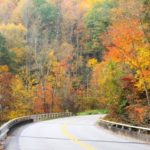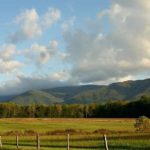If you’re wondering when to plan your visit to Pigeon Forge, fall is a fantastic time. You’ll miss all the hectic traffic of the summer, and you’ll get to witness one of the most beautiful natural wonders of the South—the cascade of colors that trickles down the Smoky Mountains as the leaves change on the trees.
The kaleidoscope of fall colors you’ll find in the Smoky Mountains is largely due to the wide variety of tree life in this part of the South. The Smoky Mountains are home to some 100 species of native trees, including American beech, mountain maple, hobblebush, and yellow birch. These higher elevation trees will begin to change colors sometime in mid to late September. Lower elevation trees will follow suit between mid-October and early November.
Whenever you decide to visit, we recommend you try these drives and hikes through the Smoky Mountains so you can make the most of your fall getaway in Pigeon Forge. For more information about Pigeon Forge cabins available during your stay, click here.
Smoky Mountain Drives
Roaring Fork Motor Nature Trail—Inside the most visited national park in the U.S.—the Great Smoky Mountains National Park—you’ll find a beautiful drive with ample opportunities for enjoying impressive fall foliage: the Roaring Fork Motor Nature Trail. This drive will take you through rich forests and offer stunning views of the Roaring Fork creek. It also has plenty of stops where you can get out and enjoy these beautiful glimpses of nature firsthand. Recommended for the fall is stop #5, where you will find the trailhead to Grotto Falls. A 2.6-mile hike roundtrip, the trail to Grotto Falls takes you through old-growth forests for an up-close view of the changing colors that you will never forget.
Smoky Mountain Hikes
Where you should hike to get the best views of fall foliage depends on the time of year you decide to visit the Smokies. During the early part of the season, you should plan to hike to higher elevations, where the leaves are first beginning to change. Later in the season (early November), you should choose lower elevations, where the last trees in the Smoky Mountains are turning and getting ready to lose their leaves for winter. Below we’ve listed a few of the better hikes for the fall, depending on the month you plan to visit.
Andrews Bald (mid to late September)—A 3.5-mile hike roundtrip, the trailhead for Andrews Bald can be found at the Clingmans Dome Area. This hike boasts outstanding panoramic views of the Smoky Mountains. And when you reach Andrews Bald, you’ll find plenty of open grassy meadows where you can stop to enjoy a picnic lunch amidst the gorgeous scenery of the Smokies.
Gregory Bald (early to mid October)—This hike is a bit longer—11.3 miles roundtrip—and should not be attempted by beginning hikers. But nature lovers who are ready for a strenuous hike will love the end result of their climb to Gregory Bald. The second of only two balds maintained by the park (the first is Andrews Bald, listed above), this 10-acre meadow is another perfect spot to scan the mountainsides and take in the fall foliage all around you.
Baskins Creek Falls (mid to late October)—If you are new to hiking or are bringing along small children, the 3-mile roundtrip hike to Baskins Creek Falls is a better choice for you. You can find this hike on the Roaring Fork Motor Nature Trail as well, and besides fall colors, this hike has a 40-foot two-tiered waterfall at its end that will be the perfect spot for a family photo you can print for your Christmas cards this year.
Abrams Falls (early November)—Another beautiful falls found off the Cades Cove Loop Road is Abrams Falls. A little longer than the hike to Baskins Creek Falls, this 5.2-mile roundtrip trail will be worth it when you see the 20-foot waterfall that’s actually the most voluminous waterfall in the park. And the path to the waterfall follows the valley floor, where you’ll find pine-oak and hemlock forests, making this trail one of the most scenic forest hikes in the Smoky Mountains.


